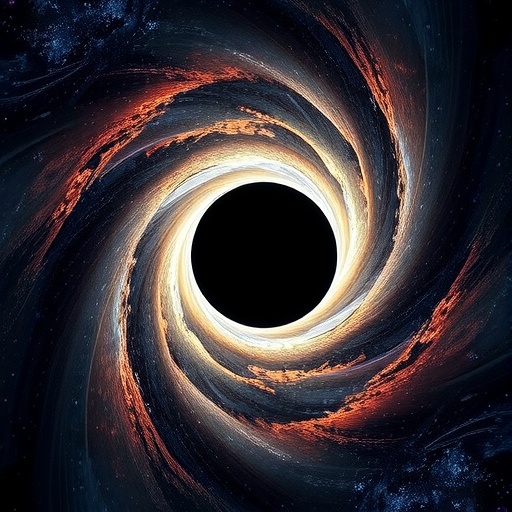Recent advancements in theoretical physics have brought us to the intriguing realm of black holes, particularly through the lens of quantum gravity. This exploration has been largely fueled by the work of scholars like Mertens and Turiaci, who delve into the complexities of quantum black holes within the framework of Jackiw-Teitelboim (JT) gravity. Their research stands at the crossroads of quantum mechanics and gravitational theories, unlocking new pathways for our understanding of the universe’s most enigmatic objects.
The study of black holes has long fascinated physicists, but the intersection of quantum theory and general relativity presents unique challenges. Traditional models of black holes are often viewed through the classical lens, offering insights into their gravitational nature yet failing to address their quantum properties. The Jackiw-Teitelboim model offers a strikingly simplified version of gravity that retains essential features found in more complex theories, thus serving as a useful tool for exploring these quantum aspects.
One of the primary advantages of JT gravity is its solvability in lower dimensions. This characteristic allows researchers to derive concrete results about black hole physics without being entangled in the complexities associated with higher-dimensional theories. Mertens and Turiaci emphasize how this approach enables a deeper understanding of black hole evaporation, information paradoxes, and potentially the holographic principle, which suggests that the information contained within a volume of space can be represented as a theory on its boundary.
In their review, Mertens and Turiaci also discuss the implications of JT gravity on the landscape of quantum black holes. For instance, the connection between JT gravity and two-dimensional conformal field theories reveals how black holes can be represented as states in a quantum system. This connection forms the backbone of an emergent understanding of black holes not merely as gravitational wells but as profound quantum objects that could challenge our fundamental notions of space and time.
One of the most captivating discussions arises from the thermodynamics of black holes as dictated by JT gravity. The researchers articulate how the temperature associated with black hole radiation, often discussed as Hawking radiation, becomes more accessible to calculate within this model. Resulting from this, their paper showcases how an equilibrium state can emerge, allowing for the establishment of a partition function that corresponds to the black hole’s thermodynamic properties.
As we grapple with these thermodynamic consequences, Mertens and Turiaci invoke the second law of thermodynamics, which prompts questions regarding entropy and information preservation in black holes. The apparent conflict presented by the information paradox—whether information that falls into a black hole is lost forever—could find a resolution within the frameworks they discuss. Their insights contribute to the broader conversation about how we might reconcile general relativity with the principles of quantum mechanics, a goal that has long eluded physicists.
Additionally, the authors provide a critical examination of how JT gravity can model black hole microstates, shedding light on what constitutes the fundamental building blocks of black holes. This avenue of investigation hints at a deeper symbiotic relationship between black holes and quantum states, invoking speculative yet fascinating ideas about the very nature of reality itself. Such discussions no longer treat black holes as merely bizarre cosmic phenomena; they instead place them at the heart of a lively dialogue on the universe’s mechanics.
Moreover, the review touches on the role of symmetry in the study of black holes within JT gravity. Symmetrically structured systems can yield profound insights into the behavior of black holes, including their formation and eventual evaporation. By exploring how these symmetric properties manifest in various calculations, Mertens and Turiaci open up new avenues for theoretical exploration that could lead to more comprehensive models of gravity.
In conjunction with theoretical development, Mertens and Turiaci also emphasize the necessity of experimental validation. While their work primarily resides in the theoretical domain, they advocate for exploring analog systems that could mimic black hole behavior. Such endeavors are crucial in elucidating the tangible implications of JT gravity and could bridge the gap between abstract theories and observable phenomena.
As their review progresses, the authors highlight the broader implications of their findings for the future of theoretical physics. The ideas stemming from JT gravity offer promising pathways towards understanding not just black holes, but also the underlying fabric of spacetime. Future investigations could explore how these principles govern other cosmic structures, fundamentally shifting our perception of the universe.
Furthermore, the implications for cosmology are tantalizing. As our understanding of black holes evolves, we may gain insights into the early universe and the conditions that led to the formation of cosmic structures. The marriage of black hole physics with cosmological models could herald a new epoch in theoretical physics, knitting together disparate threads of gravitational, quantum, and cosmological phenomena into a cohesive tapestry.
In conclusion, the work of Mertens and Turiaci shines a light on the fascinating intersection of quantum gravity and black hole theory. Their comprehensive review on solvable models of quantum black holes through Jackiw-Teitelboim gravity propels forward the dialogue on critical questions about the nature of black holes, the principles governing gravitational systems, and the pursuit of a unifying theory of physics. As the scientific community continues to engage with these concepts, one thing is certain: our quest to unravel the mysteries of black holes will persist, shaping our understanding of the cosmos for years to come.
Subject of Research: Solvable models of quantum black holes
Article Title: Solvable models of quantum black holes: a review on Jackiw–Teitelboim gravity
Article References:
Mertens, T.G., Turiaci, G.J. Solvable models of quantum black holes: a review on Jackiw–Teitelboim gravity. Living Rev Relativ 26, 4 (2023). https://doi.org/10.1007/s41114-023-00046-1
Image Credits: AI Generated
DOI: 10.1007/s41114-023-00046-1
Keywords: quantum black holes, Jackiw-Teitelboim gravity, solvable models, black hole thermodynamics, information paradox.




